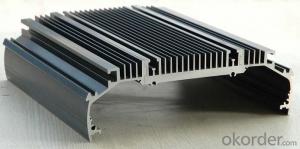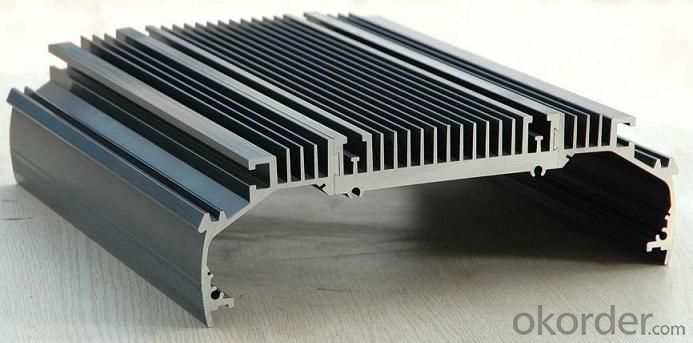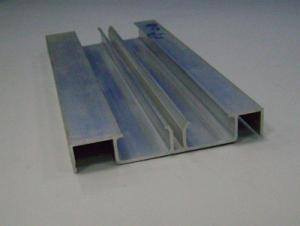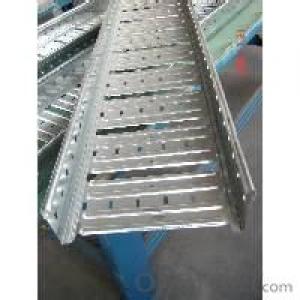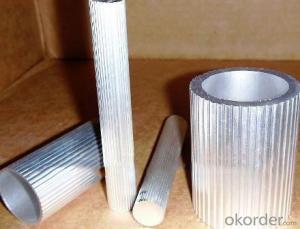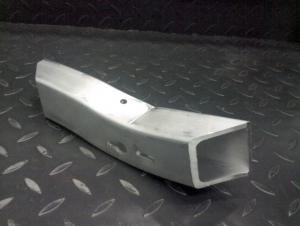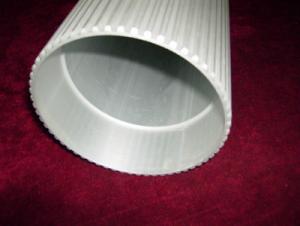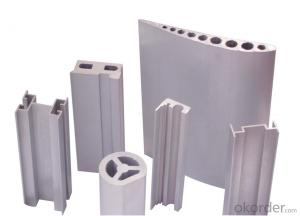Aluminum Extrusions Profiles - Aluminium Profile
- Loading Port:
- China Main Port
- Payment Terms:
- TT OR LC
- Min Order Qty:
- -
- Supply Capability:
- -
OKorder Service Pledge
OKorder Financial Service
You Might Also Like
Packaging & Delivery
| Packaging Detail: | 1. Plastic bag or EPE wrapped for each separate profile; 2. 10 or more pieces packed in a paper box; 3. Wooden case or steel rack is available; 4. Customized packing is acceptable. |
| Delivery Detail: | 20-25 days after order confirmed |
Specifications
aluminium profile
Material:6063,6061,T5/T6
Mill finish,anodized,powder coated
Cut,punch,drill,mill
ISO9001,SGS,ROHS,TUV
aluminium profile
1. Material: 6063,6061,6060,6005,6005A,etc.
2. Temper: T5 or T6
3. Finish: Mill finish, anodizing,powder coating, electrophoresis, wooden transfer or pvdf/carbon-flouride coated, polishing,brushing,sand blasting
4. Various colors: Silver,bronze,black,gold,blue,grey,champagne,bright,etc.
5. Machining: Cutting,punching,drilling,tapping,milling,bending,welding,CNC etc.
6. Various in styles and sizes:
A). Aluminum alloy bars: ranging from 1000 series to 7000 series, normal material such as 6063,6005,6061,6060, special materials such as 6082, 7005, 7075 etc.
B). Aluminum profiles:
---General aluminum profiles (various shapes of pipes/tubes, angles, T or U shapes etc.)
--- Industrial aluminum profiles ( TV frames, Rim for bicycles and motorcycles, Heat sink profiles, Furniture, Ladder, Guide Rail, Leisure materials, Shower Room, Solar Module Frame, Motor Shell, Pipeline Integration etc.)
--- Construction aluminum profiles ( Aluminum doors&windows, JB8A8, JB828 and JB828 Sliding Windows, JB50A Door Window, Curtain Wall Frame etc.)
7. Certification: ISO9001,SGS,ROHS,GMC,TUV
8. Strong technical development ability, can provide high intensity and high ductility aluminum profiles, to meet customers' different requirements.
9. OEM service available, customized design available
- Q: Can aluminum profiles be used for outdoor applications?
- Outdoor applications can indeed utilize aluminum profiles. Aluminum, known for its versatility and durability, is resistant to corrosion, making it a suitable material for outdoor environments. Its exceptional weather resistance allows it to endure exposure to sunlight, rain, and temperature fluctuations without degradation. In various fields like construction, architecture, transportation, and outdoor furniture, aluminum profiles are frequently employed due to their strength, stability, and longevity, making them a favored option for outdoor projects. Moreover, protective coatings or anodizing can be applied to aluminum profiles to enhance their resistance to the elements commonly found outdoors.
- Q: Aluminum prices are calculated by the meter, or how to quote the ah?
- Yes, for example, today's aluminum price, 10340+ processing fee 4000=14340, in addition to 1000 is equal to 14.34 yuan /KG
- Q: Do aluminum profiles come with any certifications?
- Yes, aluminum profiles often come with certifications such as the ISO 9001 quality management system certification, ISO 14001 environmental management system certification, and the RoHS (Restriction of Hazardous Substances) compliance certification. These certifications ensure that the aluminum profiles meet international standards for quality, environmental friendliness, and the absence of hazardous materials.
- Q: This question asks for a list of various interior wall cladding systems that incorporate aluminum profiles.
- <p>Aluminum profiles are versatile and commonly used in interior wall cladding systems due to their durability and aesthetic appeal. Some of the different types include: 1. Aluminum Composite Panels (ACP), which combine two aluminum sheets with a non-aluminum core. 2. Aluminum Insulated Panels, offering thermal insulation properties. 3. Aluminum Curtain Wall Systems, providing a weather-resistant exterior wall. 4. Aluminum Lining Systems, used for decorative purposes and easy maintenance. 5. Aluminum Ceiling Systems, which can also serve as wall cladding in some designs. 6. Aluminum Drywall Systems, which are lightweight and easy to install. Each system has its specific applications and advantages, making aluminum profiles a popular choice in modern architecture and interior design.</p>
- Q: Can aluminum profiles be used in structural applications?
- Yes, aluminum profiles can be used in structural applications. Aluminum is a lightweight and durable material that offers excellent strength-to-weight ratio, making it suitable for various structural applications. Aluminum profiles are commonly used in the construction industry for the fabrication of frames, beams, columns, and trusses in buildings and infrastructure. These profiles are also used in the manufacturing of automotive components, aerospace structures, and marine applications. Aluminum profiles provide advantages such as corrosion resistance, ease of fabrication, and recyclability, making them a popular choice for structural applications.
- Q: Are aluminum profiles suitable for use in automotive body structures?
- Yes, aluminum profiles are suitable for use in automotive body structures. Aluminum is a lightweight and durable material that offers several advantages in the automotive industry. Its high strength-to-weight ratio makes it an ideal choice for constructing body frames, panels, and other structural components. Using aluminum profiles in automotive body structures offers benefits such as improved fuel efficiency, as the lighter weight of the material reduces the overall weight of the vehicle. This, in turn, allows for better acceleration and handling. Additionally, aluminum possesses excellent corrosion resistance, which is crucial for withstanding harsh environmental conditions and extending the lifespan of the vehicle. Furthermore, aluminum profiles can be easily shaped and formed into complex designs, allowing for greater design flexibility in automotive body structures. This versatility enables manufacturers to create more aerodynamic and visually appealing vehicles. While aluminum profiles offer numerous advantages, there are also some considerations to be aware of. Aluminum can be more expensive than traditional steel, which may impact the overall cost of the vehicle. Additionally, the repair and maintenance of aluminum structures may require specialized equipment and expertise. However, these factors are outweighed by the benefits aluminum profiles bring to the automotive industry. In conclusion, aluminum profiles are indeed suitable for use in automotive body structures. Their lightweight, durable, and corrosion-resistant properties, along with their design flexibility, make them an excellent choice for constructing modern vehicles.
- Q: What are the different types of gaskets used with aluminum profiles?
- There are several different types of gaskets that are commonly used with aluminum profiles. 1. EPDM (Ethylene Propylene Diene Monomer) Gaskets: These gaskets are made of a synthetic rubber material that is highly resistant to weathering, UV radiation, and ozone exposure. EPDM gaskets are commonly used in outdoor applications where they need to provide a tight seal and withstand harsh environmental conditions. 2. Silicone Gaskets: Silicone gaskets are known for their excellent temperature resistance, making them a popular choice for applications that involve extreme heat or cold. They also have good resistance to chemicals and UV radiation, making them suitable for a wide range of industrial and commercial applications. 3. PVC (Polyvinyl Chloride) Gaskets: PVC gaskets are made of a plastic material that is widely used for its excellent resistance to chemicals, oil, and moisture. They are commonly used in applications where a tight seal is required, such as in doors, windows, and other architectural applications. 4. Neoprene Gaskets: Neoprene gaskets are made of a synthetic rubber material that offers good resistance to oils, chemicals, and weathering. They are commonly used in applications that require both sealing and vibration dampening, such as in machinery and equipment. 5. Nitrile Gaskets: Nitrile gaskets, also known as Buna-N gaskets, are made of a synthetic rubber material that offers excellent resistance to oils, fuels, and solvents. They are commonly used in automotive and industrial applications where resistance to oil and fuel is crucial. These are just a few examples of the different types of gaskets that can be used with aluminum profiles. The choice of gasket will depend on the specific requirements of the application, including the desired level of sealing, environmental conditions, and chemical compatibility.
- Q: This question asks for a list of various aluminum profiles that are specifically designed or used for roofing systems in regions with cold climates.
- <p>In cold climates, aluminum profiles for roofing systems are selected for their durability, strength, and resistance to harsh weather conditions. Common types include: 1. Standing Seam Profiles: These are popular for their weather-tightness and resistance to snow and ice. 2. Trapezoidal Profiles: Known for their strength and ability to handle heavy snow loads. 3. Box Rib Profiles: These provide excellent structural integrity and are suitable for areas with high wind uplift. 4. Snap-Lock Profiles: Easy to install and offer good resistance to snow and ice. 5. Corrugated Profiles: Provide a traditional look while being cost-effective and offering good drainage. 6. Panel Rib Profiles: These are designed for long spans and can withstand heavy snowfall. Each profile has specific applications and advantages, and the choice depends on the specific roofing requirements and local climate conditions.</p>
- Q: The user is asking if it's possible to use recycled aluminum to create new aluminum profiles.
- <p>Yes, recycled aluminum can be used to produce new aluminum profiles. The process of recycling aluminum is energy-efficient and environmentally friendly, as it requires significantly less energy compared to producing aluminum from raw materials. Recycled aluminum maintains the same properties as new aluminum, making it suitable for manufacturing various aluminum profiles. The recycling process typically involves melting the aluminum, which can then be cast into new shapes and forms, including profiles for construction, automotive, and other industries. This not only conserves resources but also reduces waste and carbon emissions.</p>
- Q: What are the benefits of using aluminum profiles in interior design?
- There are several benefits of using aluminum profiles in interior design. Firstly, aluminum profiles are highly versatile and can be used in a wide range of applications. They can be easily customized and fabricated to fit different design requirements. Whether you are designing a modern, minimalist space or a traditional, ornate interior, aluminum profiles offer a flexible solution. Secondly, aluminum profiles are lightweight yet durable, making them an ideal choice for interior design. They are resistant to corrosion, moisture, and temperature changes, ensuring a long lifespan. This durability also means that aluminum profiles require minimal maintenance, saving both time and money in the long run. Another benefit of using aluminum profiles is their aesthetic appeal. They come in a variety of finishes, colors, and textures, allowing designers to achieve their desired look and feel. Aluminum profiles can be anodized, powder-coated, or polished, giving them a sleek and modern appearance. They can also be designed to mimic other materials, such as wood or stainless steel, while offering the added benefits of aluminum. Additionally, aluminum profiles offer excellent thermal and acoustic insulation properties. They can help regulate temperature and reduce noise levels, creating a more comfortable and peaceful environment. This is especially beneficial in areas where soundproofing or energy efficiency is required, such as offices, hotels, or residential spaces. Lastly, aluminum profiles are eco-friendly and sustainable. Aluminum is a highly recyclable material, and using aluminum profiles in interior design helps reduce waste and minimize environmental impact. Moreover, aluminum profiles can contribute to energy efficiency by allowing natural light to enter a space, reducing the need for artificial lighting during the day. In conclusion, the benefits of using aluminum profiles in interior design are versatility, durability, aesthetic appeal, thermal and acoustic insulation, and sustainability. These qualities make aluminum profiles a popular choice among designers and architects looking to create functional and visually appealing spaces.
Send your message to us
Aluminum Extrusions Profiles - Aluminium Profile
- Loading Port:
- China Main Port
- Payment Terms:
- TT OR LC
- Min Order Qty:
- -
- Supply Capability:
- -
OKorder Service Pledge
OKorder Financial Service
Similar products
Hot products
Hot Searches
Related keywords
